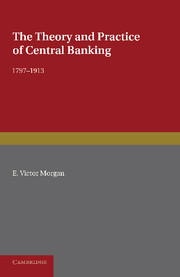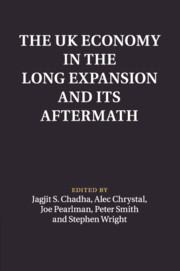Refine search
Actions for selected content:
26946 results in Economic history

The Rural Economy of Glocestershire
- Including its Dairy, Together with the Dairy Management of North Wiltshire, and the Management of Orchards and Fruit Liquor, in Herefordshire
-
- Published online:
- 05 June 2016
- Print publication:
- 18 September 2015
- First published in:
- 1789

The Theory and Practice of Central Banking, 1797–1913
-
- Published online:
- 05 June 2016
- Print publication:
- 17 October 2013

The UK Economy in the Long Expansion and its Aftermath
-
- Published online:
- 05 June 2016
- Print publication:
- 28 July 2016

The Rural Economy of Glocestershire
- Including its Dairy, Together with the Dairy Management of North Wiltshire, and the Management of Orchards and Fruit Liquor, in Herefordshire
-
- Published online:
- 05 June 2016
- Print publication:
- 18 September 2015
- First published in:
- 1789
Bringing Radio into America's Homes: Marketing New Technology in the Great Depression
-
- Journal:
- Business History Review / Volume 90 / Issue 2 / Summer 2016
- Published online by Cambridge University Press:
- 01 June 2016, pp. 251-276
- Print publication:
- Summer 2016
-
- Article
- Export citation
Index
-
- Book:
- Contractual Knowledge
- Published online:
- 05 May 2016
- Print publication:
- 26 May 2016, pp 400-402
-
- Chapter
- Export citation
Chapter Two - Financial markets, international organizations and conditional lending: A long-term perspective
- from Part One - Contracts and sovereign debt obligations: The evolution of contractual provisions
-
-
- Book:
- Contractual Knowledge
- Published online:
- 05 May 2016
- Print publication:
- 26 May 2016, pp 61-91
-
- Chapter
- Export citation
Tables
-
- Book:
- Contractual Knowledge
- Published online:
- 05 May 2016
- Print publication:
- 26 May 2016, pp viii-viii
-
- Chapter
- Export citation
Part Two - Consolidating international organizations: The mobilization of social capital and the standardization of interpretive processes
-
- Book:
- Contractual Knowledge
- Published online:
- 05 May 2016
- Print publication:
- 26 May 2016, pp 151-286
-
- Chapter
- Export citation
Copyright page
-
- Book:
- Contractual Knowledge
- Published online:
- 05 May 2016
- Print publication:
- 26 May 2016, pp iv-iv
-
- Chapter
- Export citation
Chapter Three - When governments write contracts: Policy and expertise in sovereign debt markets
- from Part One - Contracts and sovereign debt obligations: The evolution of contractual provisions
-
-
- Book:
- Contractual Knowledge
- Published online:
- 05 May 2016
- Print publication:
- 26 May 2016, pp 92-117
-
- Chapter
- Export citation
Acknowledgements
-
- Book:
- Contractual Knowledge
- Published online:
- 05 May 2016
- Print publication:
- 26 May 2016, pp xvi-xvii
-
- Chapter
- Export citation
Chapter One - Contractual knowledge: One hundred years of legal experimentation in global markets
-
-
- Book:
- Contractual Knowledge
- Published online:
- 05 May 2016
- Print publication:
- 26 May 2016, pp 1-58
-
- Chapter
- Export citation
Chapter Six - Constructing a transatlantic marketplace of disputes On the symbolic foundations of international justice
- from Part Two - Consolidating international organizations: The mobilization of social capital and the standardization of interpretive processes
-
-
- Book:
- Contractual Knowledge
- Published online:
- 05 May 2016
- Print publication:
- 26 May 2016, pp 185-214
-
- Chapter
- Export citation
Chapter Five - A tale of three cities: The construction of international commercial arbitration
- from Part Two - Consolidating international organizations: The mobilization of social capital and the standardization of interpretive processes
-
-
- Book:
- Contractual Knowledge
- Published online:
- 05 May 2016
- Print publication:
- 26 May 2016, pp 153-184
-
- Chapter
- Export citation
Chapter Seven - The duty to repair in practice: The hundred years history of a legal concept
- from Part Two - Consolidating international organizations: The mobilization of social capital and the standardization of interpretive processes
-
-
- Book:
- Contractual Knowledge
- Published online:
- 05 May 2016
- Print publication:
- 26 May 2016, pp 215-248
-
- Chapter
- Export citation
Contents
-
- Book:
- Contractual Knowledge
- Published online:
- 05 May 2016
- Print publication:
- 26 May 2016, pp v-vi
-
- Chapter
- Export citation
Chapter Nine - The rise and fall of trade and monetary legal orders: From the interwar period to today's global imbalances
- from Part Three - Structuring fields: Market dominance, complementarity and differentiation in complex institutional ecologies
-
-
- Book:
- Contractual Knowledge
- Published online:
- 05 May 2016
- Print publication:
- 26 May 2016, pp 289-323
-
- Chapter
- Export citation
Part Three - Structuring fields: Market dominance, complementarity and differentiation in complex institutional ecologies
-
- Book:
- Contractual Knowledge
- Published online:
- 05 May 2016
- Print publication:
- 26 May 2016, pp 287-399
-
- Chapter
- Export citation
Notes on contributors
-
- Book:
- Contractual Knowledge
- Published online:
- 05 May 2016
- Print publication:
- 26 May 2016, pp ix-xv
-
- Chapter
- Export citation
